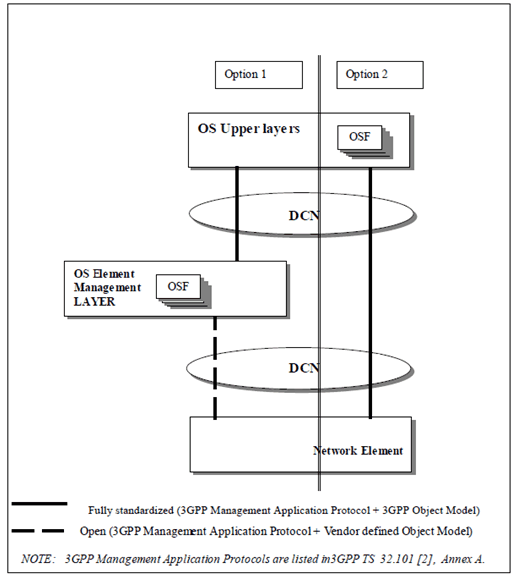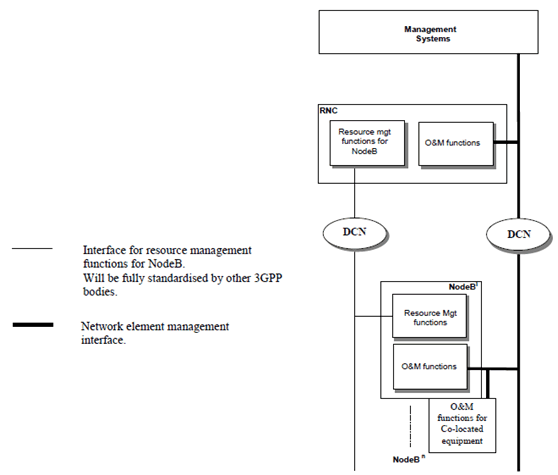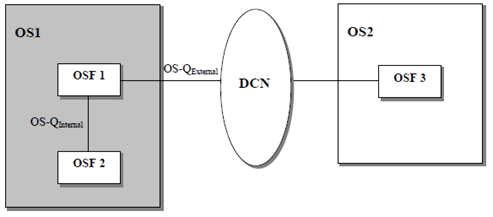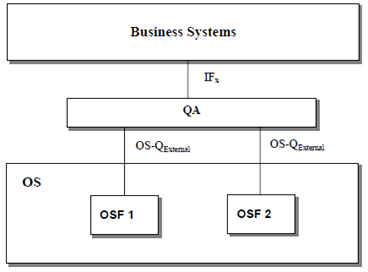Content for TS 32.102 Word version: 18.0.0
8 3GPP Management Physical architectures
8.1 Compliance Conditions
8.2 Network Element (NE) management architecture
8.3 Subnetwork Management Architecture
8.4 Operations Systems interoperability architecture
8.5 Operations Systems intra-operability architecture
8.6 Enterprise management System interconnection architecture
...
...
8 3GPP Management Physical architectures p. 24
A 3GPP Telecom Management Network will consist of many different management layers and many different building blocks. The complexity will vary greatly in detail because every organisation has different needs. The following clause will identify the most critical architectural issues and compliance conditions for a given 3GPP management interface. It should serve as fundamental requirements for any 3GPP entity (network element or management system) being a part of a 3GPP TMN.
8.1 Compliance Conditions p. 24
For a 3GPP entity (management system or NE) to be compliant to a given management interface, all the following conditions shall be satisfied:
- It implements the management functionality specified in the relevant IRP Information Service specifications.
- It provides at least one of the IRP Solution Sets (were available) related to the valid Application Protocols specified by 3GPP Application Protocols for that interface, [2] Annex C.
- It provides at least one standard networking protocol.
- In case the entity does not offer the management interface on its own, a Q Adapter shall be provided. This Q Adapter shall be provided independently of any other NE and/or management system.
- Support for Bulk Transfer Application Protocols specified by the relevant 3GPP management interface specifications applicable to that interface.
8.2 Network Element (NE) management architecture p. 25
Figure 8.2 shows two possible options for management interface from the OS upper layers to NE. Option 1, provides access to the NE via element manager, and Option 2, provides a direct access. It is sufficient to provide one or the other.
Figure 8.2 does not imply and limit the realisation of any OS physical block (e.g. E-OS, N-OS) to just one logical layer. OS physical blocks may span more than one logical layer (ITU-T Recommendation M.3010 [1]). Different types of network elements, different functional areas, operator and vendor preferences etc will put different constraints on the physical realisation of the OSFs. See further clause 9.

For a 3GPP entity (Network Element or management system) to be compliant to a given management interface the following conditions shall all be satisfied:
| Item | Compliance conditions |
|---|---|
| 1 | Implements relevant 3GPP IRP Information Service specifications. For an interface illustrated by the dashed line in Figure 4 the object model is not standardised but it shall be open |
| 2 | Application protocol (e.g. SNMP,CORBA IIOP) (Defined in TS 32.101, Annex A) If 3GPP has specified one or more IRP Solution Sets corresponding to the IRP Information Services in item 1 then at least one of those IRP Solution Sets shall be supported. (Defined in TS 32.101, Annex C) |
| 3 | Valid Network Layer Protocol (see Annex B of TS 32.101) |
| 4 | Lower protocol levels required by Item 1, 2 and 3 |
8.3 Subnetwork Management Architecture p. 27
(Example 3GPP RNC / NodeB)
An important special case of the network element management architecture is where one type of network element such as the RNC will need management information for co-ordination of a subnetwork of other types of network elements such as NodeB.
This management information shared between the RNC and NodeB will not reach the operators and is not considered to be a part of the 3GPP TMN. All other management information related to NodeB will transparently be transferred by the RNC towards the 3GPP TMN.

The same compliance conditions apply for the subnetwork management architecture as for the network element management architecture (see clause 8.2).
8.4 Operations Systems interoperability architecture p. 28
Interoperability between operations systems is an important issue in a 3GPP system. Different organisations may take different roles in a 3GPP system. The need to share information across corporate boundaries will be a consequence of this.
The heterogeneous, distributed and complex network of a 3GPP system will be a market for many different vendors. All operations systems have to interoperate and shall be able to share information. This is a critical issue in the management of third generation systems.

For a Operations System to be 3GPP TMN compliant the following conditions shall all be satisfied:
| Item | Compliance conditions |
|---|---|
| 1 | Implements relevant 3GPP IRP Information Service specifications. |
| 2 | Application protocol (e.g. SNMP,CORBA IIOP) (Defined in TS 32.101, Annex A) If 3GPP has specified one or more IRP Solution Sets corresponding to the IRP Information Services in item 1 then at least one of those IRP Solution Sets shall be supported. (Defined in TS 32.101, Annex C) |
| 3 | Valid Network Layer Protocol (see Annex B of TS 32.101) |
| 4 | Lower protocol levels required by Item 1,2 and 3 |
8.5 Operations Systems intra-operability architecture p. 29

OS-QInternal indicates an internal flow and is not standardised.
OS-QExternal indicates an external flow and shall to be compliant to a given 3GPP Management Interface satisfy the following conditions:
| Item | Compliance conditions |
|---|---|
| 1 | Implements relevant 3GPP IRP Information Service specifications. |
| 2 | Application protocol (e.g. SNMP,CORBA IIOP) (Defined in TS 32.101, Annex A) If 3GPP has specified one or more IRP Solution Sets corresponding to the IRP Information Services in item 1 then at least one of those IRP Solution Sets shall be supported. (Defined in TS 32.101, Annex C) |
| 3 | Valid Network Layer Protocol (see Annex B of TS 32.101) |
| 4 | Lower protocol levels required by Item 1,2 and 3 |
8.6 Enterprise management System interconnection architecture p. 30
The business enterprise layer has in the second-generation systems a very low degree of standardisation. Operators have legacy systems or more IT influenced systems often adopted to every organisations different needs. Enterprise management systems are not a part of a 3GPP TMN.

Figure 8.6: Enterprise management Systems interconnection architecture
(⇒ copy of original 3GPP image)
(⇒ copy of original 3GPP image)
OS-QExteral indicates an external flow and shall to be compliant to a given 3GPP management interface satisfy the following conditions:
| Item | Compliance conditions |
|---|---|
| 1 | Implements relevant 3GPP IRP Information Service specifications. |
| 2 | Application protocol (e.g. SNMP,CORBA IIOP) (Defined in TS 32.101, Annex A) If 3GPP has specified one or more IRP Solution Sets corresponding to the IRP Information Services in item 1 then at least one of those IRP Solution Sets shall be supported. (Defined in TS 32.101, Annex C) |
| 3 | Valid Network Layer Protocol (see Annex B of TS 32.101) |
| 4 | Lower protocol levels required by Item 1,2 and 3 |
IFX indicates an external flow and shall to be compliant to a given 3GPP management interface satisfy the following condition:
| Item | Compliance conditions |
|---|---|
| 1 | Not standardised but open |